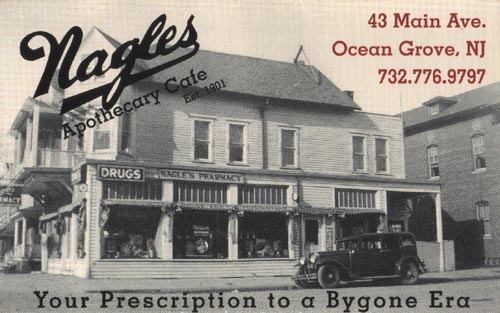Where Have All the Nice Places Gone?
Several posts ago, I discussed the dearth of decent, new public spaces in Jersey City. This problem with new development and construction exists well beyond Jersey City (Alex Marshall analyzes this distressful pattern in a recent article in Governing magazine). My past discussion centered upon public spaces: parks, libraries, and government buildings. The architecture and aura of private spaces fail to stand as alternative sources of hope.
In October, my wife and I enjoyed our second annual autumn trip to the Jersey Shore. Yes, most folks prefer the beach in summer. We do not like the heat, the sun, or the crowds. This preference is just one of many reasons that might explain our pairing. While staying at our favorite bed and breakfast in Ocean Grove, New Jersey, we patronized Nagle’s Apothecary Cafe.

(Courtesy of Bridge and Tunnel Club)
Nagle’s is an odd and charming establishment and fits perfectly with the old-fashioned Americana aesthetic and society of Ocean Grove. Established in 1901, Nagle’s operated as a pharmacy until 1980 (this date is unconfirmed). Today, Nagle’s is a diner and ice cream shop. Popular for its homemade ice cream, hearty breakfasts, and classic diner fixings, Nagle’s resembles a pharmacy from days of yore. Bottles, jars, packaging, and measuring tools sit in glass cases lining the walls. Decorative black-and-white tiles cover the flooring. If you have ever watched It’s a Wonderful Life, you might remember that George Bailey worked as a delivery boy at Gower’s Drugs. Picture Gower’s and you’ll understand Nagle’s.
While sitting at a table and enjoying a satisfying ice cream sundae–a house specialty–I glanced around the restaurant and felt a physical, psychological, and even spiritual sense of pleasure. Nagle’s treats the senses.
During both phases of its life, a village druggist and presently a village eatery, Nagle’s was and is an everyday and foremost functional place. It is a business: it must attract customers and earn a profit to survive. It was not founded and certainly doesn’t run as a public work or a civic amenity. Although it remains a place for regular people, Nagle’s is attractive, enticing, and interesting. Simply put: it’s nice.

An afternoon crowd at Nagle’s. Notice the interior design and decorations (Courtesy of Tinsel Creation).
Think of the many “old” or “restored” spaces which we wrap and drape in nostalgia: pubs, train stations, post offices, department stores, movie theaters, or diners. These were constructed and still operate as everyday spaces for everyday people. These are not grand hotels, august museums, or private social clubs (they are wonderful, too). Nonetheless, they are great spaces displaying high aesthetics and quality craftsmanship. Such spaces evoke a sense of aspiration and importance. Everyday businesses aimed to make their patrons and customers feel proud and valued.
If you rode coach on a train, you still walked through the soaring halls of Union Station in Washington, D.C. If you bought a ticket to the Loew’s in Jersey City, your movie-going experience mirrored that of a blue-blooded patron of the Metropolitan Opera. Whether getting your shoes shined at the train station, sinking into a plush red seat at the movie theater, or savoring a cup of coffee at the drugstore lunch counter, you felt important. You were somebody. You mattered.
Today, most buildings are fashioned with the cheapest materials, built as quickly as possible, and exude as much charm as an overflowing latrine. Make a shopping trip to the mall. Walk through a bus station. Even many contemporary churches feel as holy as an outlet store.
Where have all the nice places gone? Can we dream up and build new ones? Why do errands, commuting, and daily living need to be soul-crushing? Do we still deem our societies, our communities, and our individual selves important enough to experience refinement in the smallest things, from mailing a letter to filling a prescription?
Judging from the crowd at Nagle’s on that Sunday night–teenagers gossiping over ice cream and soda, a pair of elderly couples sharing a meal, a solitary man relishing a hamburger, and out-of-town visitors admiring the baubles and design flourishes of the eatery–many of us still do.